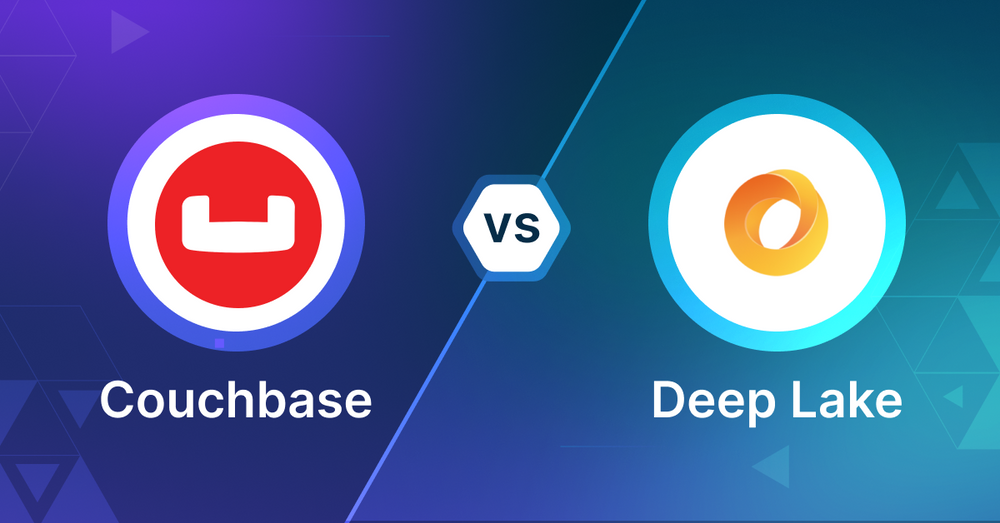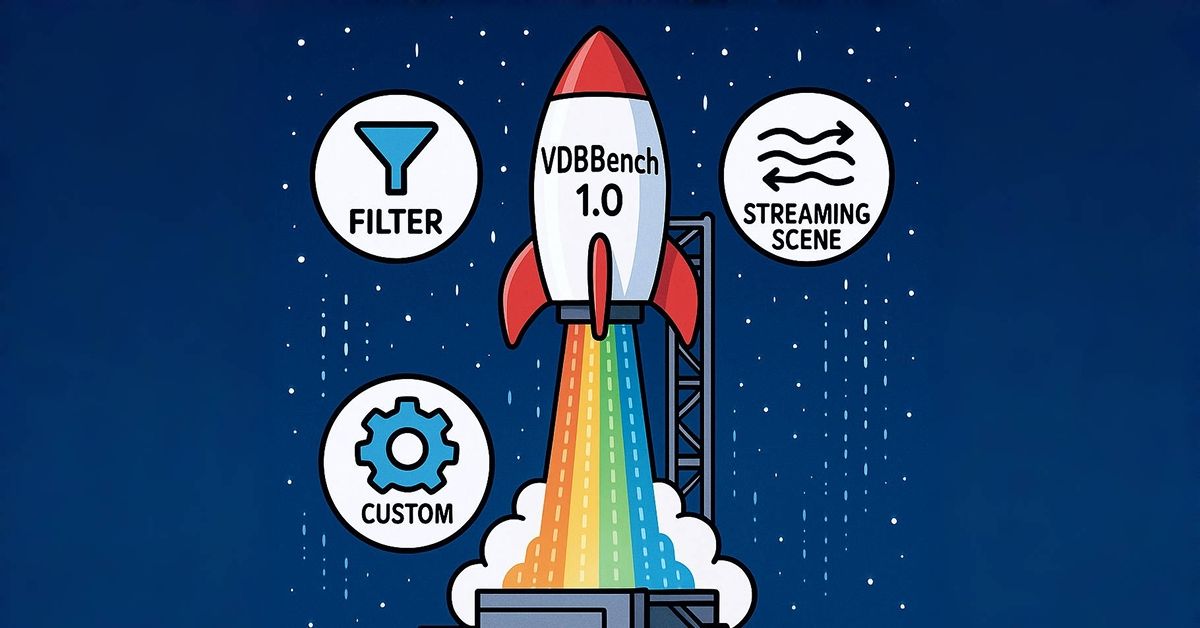Couchbase vs Deeplake: Choosing the Right Vector Database for Your AI Apps

What is a Vector Database?
Before we compare Couchbase and Deeplake, let's first explore the concept of vector databases.
A vector database is specifically designed to store and query high-dimensional vectors, which are numerical representations of unstructured data. These vectors encode complex information, such as the semantic meaning of text, the visual features of images, or product attributes. By enabling efficient similarity searches, vector databases play a pivotal role in AI applications, allowing for more advanced data analysis and retrieval.
Common use cases for vector databases include e-commerce product recommendations, content discovery platforms, anomaly detection in cybersecurity, medical image analysis, and natural language processing (NLP) tasks. They also play a crucial role in Retrieval Augmented Generation (RAG), a technique that enhances the performance of large language models (LLMs) by providing external knowledge to reduce issues like AI hallucinations.
There are many types of vector databases available in the market, including:
- Purpose-built vector databases such as Milvus, Zilliz Cloud (fully managed Milvus)
- Vector search libraries such as Faiss and Annoy.
- Lightweight vector databases such as Chroma and Milvus Lite.
- Traditional databases with vector search add-ons capable of performing small-scale vector searches.
Couchbase is distributed multi-model NoSQL document-oriented database with vector search capabilities as an add-on and Deep Lake is a data lake optimized for vector embeddings. This post compares their vector search capabilities.
What is Couchbase? An Overview
Couchbase is a distributed, open source NoSQL database for cloud, mobile, AI and edge computing. It combines the best of relational databases with the flexibility of JSON. Couchbase also allows you to do vector search even though it doesn’t have native vector indexes. Developers can store vector embeddings—numerical representations generated by machine learning models—within Couchbase documents as part of their JSON structure. These vectors can be used in similarity search use cases such as recommendation systems or retrieval-augmented generation both based on semantic search where finding data points close to each other in a high dimensional space is important.
One way to do vector search in Couchbase is by using Full Text Search (FTS). FTS is designed for text search but can be used for vector search by converting vector data into searchable fields. For example, vectors can be tokenized into text-like data and FTS can index and search based on those tokens. This will give you approximate vector search and a way to query documents with vectors that are close in similarity.
Alternatively developers can store the raw vector embeddings in Couchbase and do the vector similarity calculations at the application level. This means retrieving documents and computing metrics such as cosine similarity or Euclidean distance between vectors to find the closest matches. This way Couchbase will be used as storage for vectors and the application will handle the math.
For more advanced use cases some developers integrate Couchbase with specialized libraries or algorithms that enable vector search. These integrations allow Couchbase to manage the document store and the external libraries will do the actual vector comparisons. This way Couchbase can still be part of a solution that does vector search.
By using these approaches Couchbase can be used for vector search functionality and be a flexible option for various AI and machine learning use cases that require similarity search.
What is Deep Lake? An Overview
Deep Lake is a specialized database system designed to handle the storage, management, and querying of vector and multimedia data, such as images, audio, video, and other unstructured data types, which are increasingly used in AI and machine learning applications. Deep Lake can be used as a data lake and a vector store:
Deep Lake as a Data Lake: Deep Lake enables efficient storage and organization of unstructured data, such as images, audio, videos, text, medical imaging formats like NIfTI, and metadata, in a version-controlled format designed to enhance deep learning performance. It allows users to quickly query and visualize their datasets, facilitating the creation of high-quality training sets.
Deep Lake as a Vector Store: Deep Lake provides a robust solution for storing and searching vector embeddings and their associated metadata, including text, JSON, images, audio, and video files. You can store data locally, in your preferred cloud environment, or on Deep Lake's managed storage. Deep Lake also offers seamless integration with tools like LangChain and LlamaIndex, allowing developers to easily build Retrieval Augmented Generation (RAG) applications.
Key Differences
Search Methodology:
Couchbase uses Full Text Search (FTS) for approximate vector search by converting vector data into searchable fields. It can also store raw vector embeddings, with similarity calculations done at the application level.
Deep Lake is built specifically for vector search, offering native support for storing and querying vector embeddings. It uses specialized algorithms optimized for high-dimensional data.
Data Handling:
Couchbase excels in managing structured and semi-structured data, primarily working with JSON documents. It can store vector embeddings within these documents.
Deep Lake is designed to handle unstructured data types like images, audio, and video, alongside vector embeddings and metadata. It supports a wider range of data formats out-of-the-box.
Scalability and Performance:
Couchbase is known for its distributed architecture, allowing horizontal scaling across multiple nodes. Its performance for vector search may vary depending on the implementation method.
Deep Lake is built to scale for large datasets of unstructured data and vector embeddings. It's optimized for high-performance vector similarity searches.
Flexibility and Customization:
Couchbase offers flexibility in data modeling with its JSON document structure. Vector search functionality can be customized through application-level implementations or integrations with external libraries.
Deep Lake provides built-in support for vector operations and similarity search. It offers flexibility in storage options, allowing local, cloud, or managed hosting.
Integration and Ecosystem:
Couchbase has a mature ecosystem and integrates well with various data processing and analytics tools. For vector search, it may require additional integrations or custom implementations.
Deep Lake integrates seamlessly with popular machine learning frameworks and tools like LangChain and LlamaIndex, making it easier to build AI-powered applications.
Ease of Use:
Couchbase has a steeper learning curve for vector search as it requires custom implementations or workarounds to achieve this functionality.
Deep Lake is purpose-built for vector and multimedia data, potentially offering a more straightforward experience for vector search use cases.
Cost Considerations:
Couchbase pricing is based on nodes and features used. Vector search functionality might incur additional costs depending on the implementation method.
Deep Lake offers both open-source and enterprise versions. Pricing for managed services may vary based on storage and computation needs.
Security Features:
Couchbase provides robust security features including encryption, authentication, and role-based access control.
Deep Lake offers security features, but the extent may vary between open-source and enterprise versions.
When to Choose Each Technology
Couchbase: Use when you need a NoSQL database that can handle structured and semi-structured data and vector search. For projects that need a mix of document storage and vector similarity search. Use Couchbase if you already use it as your primary database and want to add vector search without introducing a new system. Good for applications that need strong consistency, real-time data access and ACID transactions and vector search. Couchbase is good when you need to scale horizontally across multiple nodes and high performance for all data operations.
Deep Lake: Use when your primary focus is on managing and querying vector embeddings and unstructured data for AI applications. Better for projects heavily focused on machine learning and AI especially image, audio, video data. Use Deep Lake when you need native vector operations and high performance similarity search without extra implementation work. Use it when you need version control of datasets and efficient creation of training sets for machine learning models. Deep Lake is good when you need seamless integration with AI frameworks and tools like LangChain and LlamaIndex for building AI applications.
Conclusion
Couchbase is good as a general purpose NoSQL database that can handle vector search. Its strengths are in handling multiple data types, strong consistency and a mature ecosystem for enterprise applications. Useful when vector search is just one part of a larger data management strategy.
Deep Lake is good for vector and multimedia data management. Built-in vector search, unstructured data support and AI tool integration makes it a good fit for machine learning and AI projects. Good when efficient vector embeddings and similarity search is a core requirement.
Choose between Couchbase and Deep Lake based on your use case, data types and performance requirements. Consider your existing infrastructure, size of your vector search operations and your team’s expertise. If you need a database with vector search Couchbase might be the way to go. If your project is around AI and machine learning with focus on vector and multimedia data Deep Lake might be the better choice. Test both with your data and use cases to get more insight.
While this article provides an overview of Couchbase and Deeplake, it's key to evaluate these databases based on your specific use case. One tool that can assist in this process is VectorDBBench, an open-source benchmarking tool designed for comparing vector database performance. Ultimately, thorough benchmarking with specific datasets and query patterns will be essential in making an informed decision between these two powerful, yet distinct, approaches to vector search in distributed database systems.
Using Open-source VectorDBBench to Evaluate and Compare Vector Databases on Your Own
VectorDBBench is an open-source benchmarking tool designed for users who require high-performance data storage and retrieval systems, particularly vector databases. This tool allows users to test and compare the performance of different vector database systems such as Milvus and Zilliz Cloud (the managed Milvus) using their own datasets and determine the most suitable one for their use cases. Using VectorDBBench, users can make informed decisions based on the actual vector database performance rather than relying on marketing claims or anecdotal evidence.
VectorDBBench is written in Python and licensed under the MIT open-source license, meaning anyone can freely use, modify, and distribute it. The tool is actively maintained by a community of developers committed to improving its features and performance.
Download VectorDBBench from its GitHub repository to reproduce our benchmark results or obtain performance results on your own datasets.
Take a quick look at the performance of mainstream vector databases on the VectorDBBench Leaderboard.
Read the following blogs to learn more about vector database evaluation.
Further Resources about VectorDB, GenAI, and ML
- What is a Vector Database?
- What is Couchbase**? An Overview**
- What is Deep Lake? An Overview
- **Key Differences** 
- **When to Choose Each Technology**
- Conclusion
- Using Open-source VectorDBBench to Evaluate and Compare Vector Databases on Your Own
- Further Resources about VectorDB, GenAI, and ML
Content
Start Free, Scale Easily
Try the fully-managed vector database built for your GenAI applications.
Try Zilliz Cloud for FreeKeep Reading

How to Build an Enterprise-Ready RAG Pipeline on AWS with Bedrock, Zilliz Cloud, and LangChain
Build production-ready enterprise RAG with AWS Bedrock, Nova models, Zilliz Cloud, and LangChain. Complete tutorial with deployable code.

Announcing VDBBench 1.0: Open-Source VectorDB Benchmarking with Your Real-World Production Workloads
VDBBench 1.0 offers an open-source benchmarking solution for vector databases, emphasizing real-world production conditions, including streaming data and concurrent workloads.

What is the K-Nearest Neighbors (KNN) Algorithm in Machine Learning?
KNN is a supervised machine learning technique and algorithm for classification and regression. This post is the ultimate guide to KNN.
The Definitive Guide to Choosing a Vector Database
Overwhelmed by all the options? Learn key features to look for & how to evaluate with your own data. Choose with confidence.